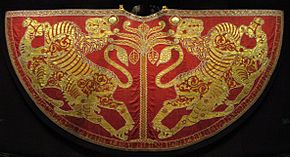
Kermes is a red dye derived from the dried bodies of the females of a scale insect in the genus Kermes, primarily Kermes vermilio. The Kermes insects are native in the Mediterranean region and are parasites living on the sap of the host plant, the Kermes oak (Quercus coccifera) and the Palestine oak (Quercus calliprinos).[1]
These insects were used as a red dye since antiquity by the ancient Egyptians, Mesopotamians, Indians, Greeks, Romans, and Iranians. The dye also served a number of ritual and practical purposes in the Hebrew Bible.
The kermes dye is a rich red, a crimson. It has good colour fastness in silk and wool. It was much esteemed in the medieval era for dyeing silk and wool, particularly scarlet cloth. Post-medievally it was replaced by other red dyes, starting with cochineal.
https://en.wikipedia.org/wiki/Kermes_(dye)
Etymology
Kermes ultimately derives from the Sanskrit word कृमिज or kṛmija meaning "worm-made".[2] This was adopted into Persian and later Arabic as قرمز qermez. The modern English word kermes was borrowed from the French term kermès.
https://en.wikipedia.org/wiki/Kermes_(dye)
| Scale insect Temporal range:
| |
|---|---|

| |
| Waxy scales on cycad leaf | |
| Scientific classification | |
| Domain: | Eukaryota |
| Kingdom: | Animalia |
| Phylum: | Arthropoda |
| Class: | Insecta |
| Order: | Hemiptera |
| Suborder: | Sternorrhyncha |
| Infraorder: | Coccomorpha Heslop-Harrison, 1952 |
| Superfamily: | Coccoidea Handlirsch, 1903 [1] |
| Families | |
Scale insects are small insects of the order Hemiptera, suborder Sternorrhyncha. Of dramatically variable appearance and extreme sexual dimorphism, they comprise the infraorder Coccomorpha which is considered a more convenient grouping than the superfamily Coccoidea due to taxonomic uncertainties. Adult females typically have soft bodies and no limbs, and are concealed underneath domed scales, extruding quantities of wax for protection. Some species are hermaphroditic, with a combined ovotestis instead of separate ovaries and testes. Males, in the species where they occur, have legs and sometimes wings, and resemble small flies. Scale insects are herbivores, piercing plant tissues with their mouthparts and remaining in one place, feeding on sap. The excess fluid they imbibe is secreted as honeydew on which sooty mold tends to grow. The insects often have a mutualistic relationship with ants, which feed on the honeydew and protect them from predators. There are about 8,000 described species.
The oldest fossils of the group date to the Early Cretaceous, preserved in amber. They were already substantially diversified by this time suggesting an earlier origin during the Triassic or Jurassic. Their closest relatives are the jumping plant lice, whiteflies , phylloxera bugs and aphids. The majority of female scale insects remain in one place as adults, with newly hatched nymphs, known as "crawlers", being the only mobile life stage, apart from the short-lived males. The reproductive strategies of many species include at least some amount of asexual reproduction by parthenogenesis.
Some scale insects are serious commercial pests, notably the cottony cushion scale (Icerya purchasi) on Citrus fruit trees; they are difficult to control as the scale and waxy covering protect them effectively from contact insecticides. Some species are used for biological control of pest plants such as the prickly pear, Opuntia. Others produce commercially valuable substances including carmine and kermes dyes, and shellac lacquer. The two red colour-names crimson and scarlet both derive from the names of Kermes products in other languages.
https://en.wikipedia.org/wiki/Scale_insect
No comments:
Post a Comment